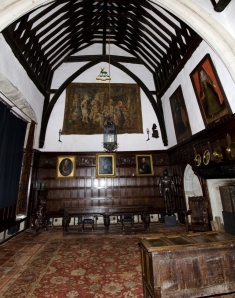About 2 months ago I set off for Ightham Mote in Kent to begin the data collection for my second digital project. Working with a team of PhD students from the Institute of Sound and Vibration Research at Southampton our intention was to record the Impulse Response for three areas of the building: the Hall, the Old Chapel and the Oriel Room. This would be used to create a model of the building in CATT-Acoustic and to calculate values for clarity and intelligibility when we returned to Southampton.
The work was undertaken after the building was closed to the public as we needed each space to be empty and required a constant level of background noise. We used a lot of different bits of equipment as the ISVR students wanted to use the data for other things while I was very interested in modelling with it to compare the acoustical experiences of the space to the experience of medieval space from Visualisation. We used a microphone, Kemar (Binural microphone), omnidirectional speaker and Loud speaker to record the space in the Oriel chamber and the Old Chapel while in the Great hall we used a loud speaker but also used an omnidirectional microphone.

Kemar (binaural microphone), omnidirectional microphone, measurement microphone and microphone array and amplifier
In each space we had two source positions to allow us to compare the experience of sound being produced from two different locations, and at least six receiver positions. It was my task to select *interesting* locations for these positions. They were selected based on different experiences of the space, so in the chapel I choose source and receiver positions related to whether you were performing a service or listening to the service. In the Oriel room positions close to and further away from the squint were selected. In the Great Hall I choose positions at the high status end of the room and the further down as well as a position that a musician would perform from.
We used a sin curve sound to record the impulse response (pink noise) which allows us to record most frequencies of sound that occur within nature.
After recording the acoustical properties of the room it was also necessary to undertake a basic measured survey of the room. This did not need to be as accurate as a building survey but did need to include different areas of materials to allow us to model the acoustical properties of the space. To do this I have been using CATT-Acoustic. It requires me to enter the dimensions of the room in terms of corners and planes created from coordinates.
I have really enjoyed getting use to this none graphical way of modelling. I am use to clicking, dragging and selecting which is very straight forward, so this was an entirely new experience. Although to begin with I didn’t find this method of coding easy once I got started and got my head around what measurements were needed and which extra corners I would need to define to be able to create planes it was speedy. Though as with any coding it required quite a bit of debugging. I also found, that as with pretty much any fieldwork, as soon as I got back I realised I needed to go back and take a load of new different measurements and take lots of photos. For this I have to give lots of credit to Camilla Rowe who came up for the day to give me a hand speeding the whole process up.
I’m really looking forward to getting on with the actual acoustics end of the work next. It feels strange working visually to produce something that is going to be used to model noise. These ideas are something I will be exploring further in my thesis.






